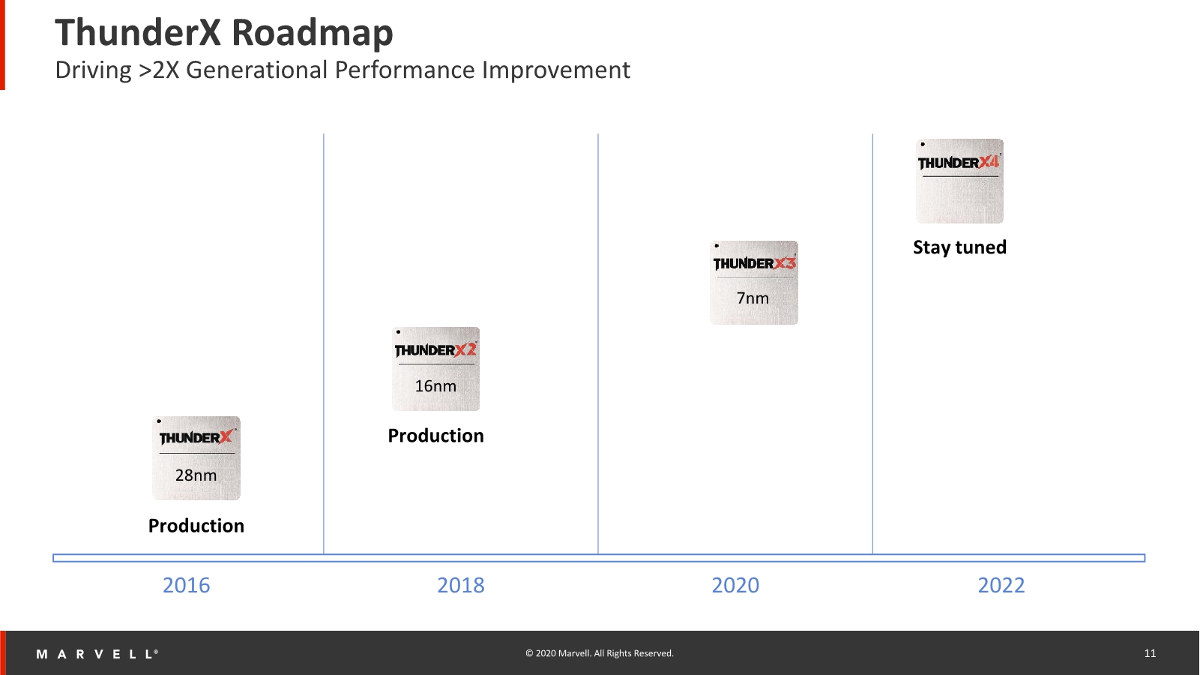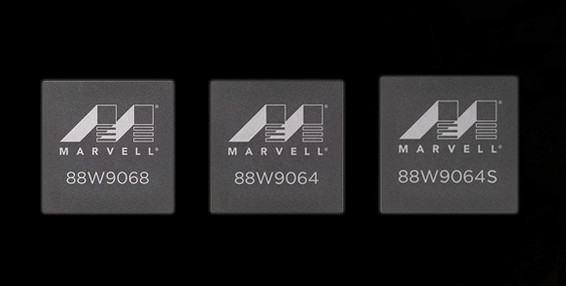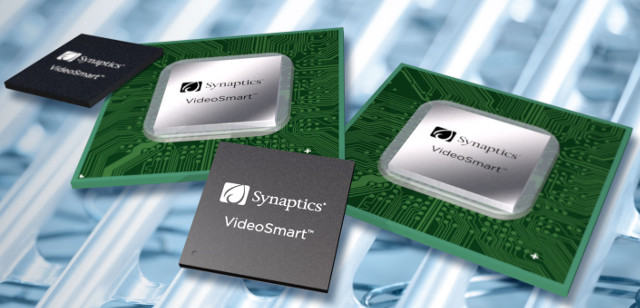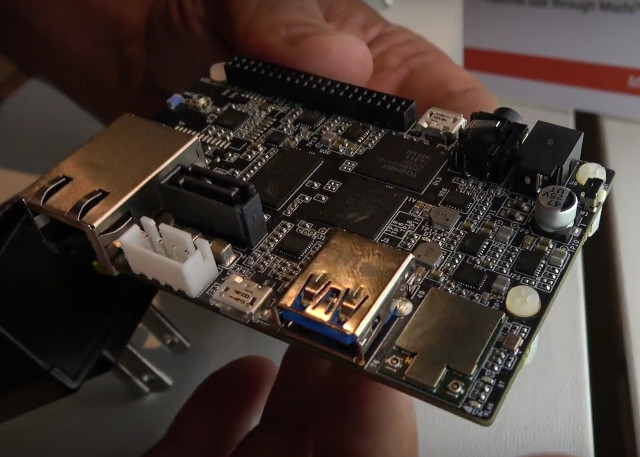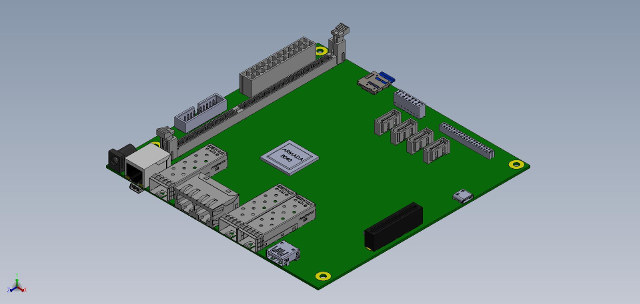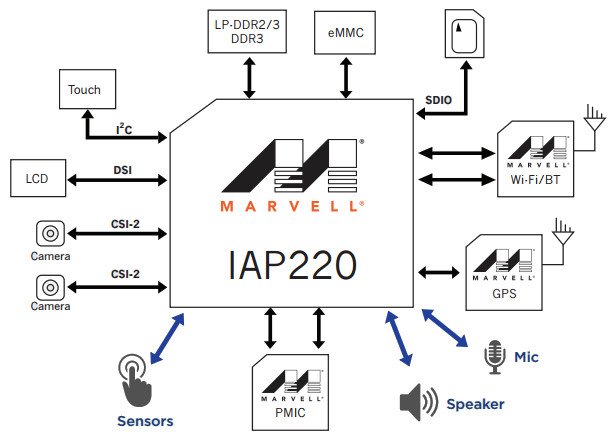Cavium first unveiled their 48-core 64-bit Arm ThunderX server processor in 2014, before following up with ThunderX2 featuring up to 56 cores @ 3.0 GHz providing 2 to 3 more performance compared to the first generation. Since then, the company has been acquired by Marvell, and now the latter has just announced ThunderX3 third-generation server processor with up to 96 cores, 384 threads in a single socket. Marvell explains that while x86 servers were historically designed to handle many applications for several thousand users, the market has changed and now servers are becoming more specialized, and for example, given the task to run one application used by millions of users. This change in the market provides opportunities for Arm server processors that do not have legacy features and can be highly customized and optimized. ThunderX3 key features: Up to 96 custom-designed Armv8.3+ cores @ up to 3.0 GHz 4 threads […]
Marvell OCTEON TX2 CN9130, CN9131 and CN9132 SoCs Target 5G Base Stations, Edge Networking, Storage Applications
A while ago, I was informed three new Marvell processors had made it to mainline Linux, namely CN9130, CN9131, and CN9132, but at the time, the description was a bit cryptic: The CN9130 is made of one AP807 and one internal CP115. There are three development boards that are made of this SoC: * CN9130-DB * CN9131-DB (with one additional modular CP115 compared to CN9130-DB) * CN9132-DB (with two additional modular CP115 compared to CN9130-DB) No other public information was available either, but Marvell has now published more details and those are OCTEON TX2 Infrastructure processors with four Cortex-A72 cores @ 2.2 GHz, up to 18x SERDES IO, and 10GbE. Octeon TX2 CN9130 key features and specifications: CPU – Quad-core Armv8 Cortex-A72 @ up to 2200 MHz with 48 KB I-cache, 32 KB D-cache, 1 MB total L2 cache divided into two clusters of 512 KB ECC shared cache, 1MB […]
Wi-Fi Certified 6 Program Available for Products based on Broadcom, Cypress, Intel, Marvell, and Qualcomm 802.11ax Chips
Last year the WiFi alliance introduces a new naming scheme for WiFi using numbers instead of IEEE standards so that WiFI 4 is 802.11n, WiFi 5 is 802.11ac, and WiFi 6 is the latest 802.11ax standard with data throughput up to 10 Gbps, and a better ability to manage high-density scenarios. Shortly after (November 2018) we also got news of the first WiFi 6 routers from ASUS and NETGEAR, but the WiFi alliance only just announced the launch of their Wi-Fi Certified 6 program that promises optimal interoperability and security. The program will make sure the following features are properly implemented: WPA3 WiFi security Orthogonal frequency division multiple access (OFDMA): effectively shares channels to increase network efficiency and lower latency for both uplink and downlink traffic in high demand environments Multi-user multiple input multiple output (MU-MIMO): allows more downlink data to be transferred at once and enables an access point […]
Marvell 802.11ax WiFi Chips are Designed for Enterprise Gateways, Mainstream Routers, and Set-Top Boxes
High-Efficiency Wireless (HEW), better known as 802.11ax, is a new WiFi standard that is supposed to deliver up to 10 Gbps bandwidth over 2.4 and 5.0 GHz frequencies, and improve the average throughput per user by a factor of at least 4 times in dense environments. Several draft of the specifications have been voted on, but the latest 802.11ax timeline seems to indicate the final 802.11ax specifications will only be approved sometimes in 2019. This has not prevented companies to announce or unveil 802.11ax SoC or solutions based on the draft specifications, as we’ve seen in the past with NXP Layerscape LA1575 programmable WiSoC, Qualcomm gateway reference design, and Broadcom Max WiFi chips. Marvell has now joined the fray with their 802.11ax wireless portfolio. All Marvell 802.1ax WiSoCs support all using uplink & download OFDMA / MU-MIMO, 1024 QAM, off-channel spectrum scanning, dedicated in-service monitoring, and precision location. Three SKUs […]
Synaptics Introduces VideoSmart BG5CT 4K HDR Multimedia Video Processor for Set-Top Boxes
Marvell used to design Media SoCs running Android TV such as ARMADA 1500 Ultra (aka BG4CT). That part of Marvell business has very recently been sold to Synaptics, which has just unveiled VideoSmart BG5CT multimedia SoC with 4K “Advanced” HDR video processing for the set-top-box market. The BG5CT is said to be pin-to-pin compatible with BG4CT Android TV SoC, features a quad core ARM CPU @ 1.6 GHz with 15K DMIPS, an Imagination PowerVR Series8XE GE8310 GPU, and a security engine enabling secure boot, Trusted Rendering Path, full TrustZone, and video watermarking carrier-grade security making it suitable for Pay TV operators and set-top-box manufacturers. Synaptics’ Qdeo video processing technology adds 4K “Advanced HDR” – including HDR10, HLG, Dolby Vision, and Technicolor HDR, among user video processing technology. The company did not provide that many details, but BG5CT appears to mostly add HDR support compared to BG4CT, and replace Vivante GC7000 GPU by […]
AndromedaBox Networking Edge Board Includes a Dual Core Marvell Processor, SATA, Gigabit Ethernet, and More
Last year, Marvell introduced AndroMeda Box Edge IoT board using 96Boards form factor and running Brillo (now Android Things), but the company has been working on the similarly named AndromedaBox Networking Edge (ANE) board with a tweaked version of 96Boards form factor including Gigabit Ethernet and SATA, and powered by a dual core ARMADA 3700 processor. AndromedaBox Networking Edge specifications: SoC – Marvell ARMADA LP 3700 dual-core ARM Cortex 53 processor @ up to 1.2 GHz System Memory – 512MB LPDDR4 Storage – 8GB eMMC flash, 1x SATA 3.0 port Connectivity – 1x Gigabit Ethernet RJ45 port, 1×1 802.11ac Wi-Fi, and Bluetooth 4.2 USB – 2x micro USB 2.0 port, 1x USB 3.0 port Expansion – 1x PCIe 2.0 (maybe via a slot on the back of the board), 40-pin LS (Low Speed) Expansion connector Power Supply – Likely 8 to 18V input as per 96Boards specs Dimensions – 85 […]
ARMADA 8040 Networking Community Board with a Quad Core ARM Cortex A72 SoC Coming Soon for $300 and Up
Developers interested in ARMv8 server or networking boards are starting to have more and more affordable choices. After AMD Opteron A1100 series based LeMaker Cello board, and Softiron Overdrive 1000 server, SolidRun is now working on ARMADA 8040 networking community board powered by Marvell ARMA8040 quad core Cortex A72 network processor. ARMADA 8040 networking board (mrvl8040) preliminary specifications: SoC – ARMADA 8040 (88F8040) quad core Cortex A72 processor @ up to 2.0 GHz with MoChi architecture System Memory – 4GB DDR4 DIMM by default Storage – 4x SATA 3.0 port + micro SD slot Connectivity – 1x Gigabit RJ45 port, 1x SFP SGMII @ 2.5Gbps, dual 10Gbps copper with auto switchover to dual SFP+ Expansion – 1x PCIe-x4 3.0 slot, Linaro 96Boards expansion slot exposing GPIO, UART, I2C and SPI, Marvell TDM module header USB – 1x USB 3.0 port, 2x micro USB ports Debugging – Console port (UART) over […]
Marvell IAP220 “IoT” Processor Targets Low Power Touchscreen Enabled Appliances
After IAP140 quad core Cortex A53 processor found in Brillo compatible AndroMeda Box Edge, Marvell has recently introduced another IAP processor for the Internet of Things with IAP220 dual core Cortex A7 processor targeting “low power cost sensitive home automation, industrial, security, and wearable applications”. IAP220 SoC specifications: Processor – Dual ARM Cortex-A7 core up to 1.0 GHz GPU – 3D GPU with OpenGL ES 1.1/2.0 support MCU – ARM Cortex M4F Memory I/F – LP-DDR2/3, DDR3 Storage – eMMC and SDIO interfaces Display – MIPI video and command mode; LCD display Video – Full HD encode and decode with H.264, MPEG-4, H.263, MJPEG and more Camera – Digital video camera interface, 2x, 2-lane CSI Audio – I2S, TDM; support for multiple PDM (pulse-density modulation) microphones and speakers Sensor hub • Low power sensor processing Management I/O – SPI, GPIO, PWM? (the product brief says PWD instead), UART, 1-wire, I2C […]


